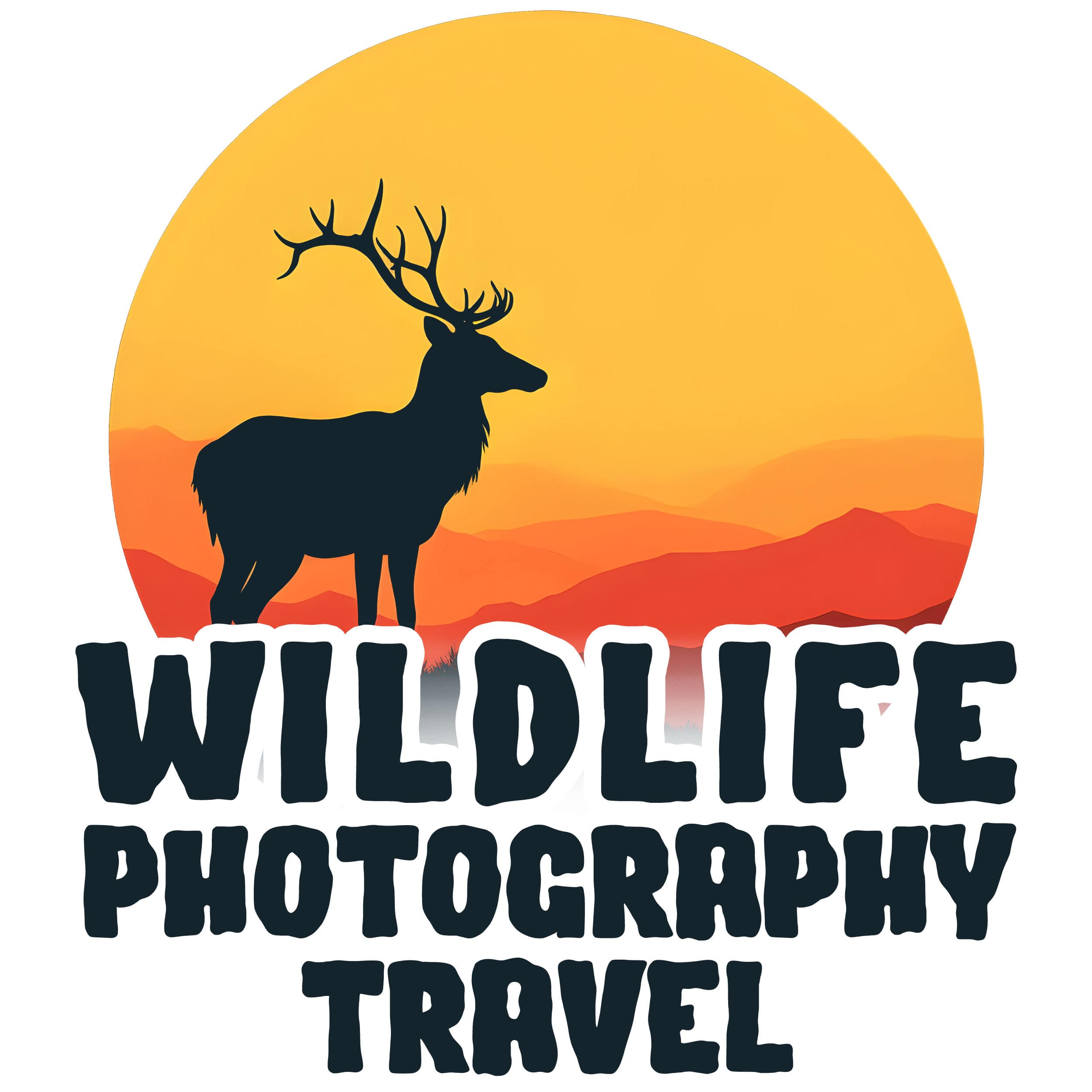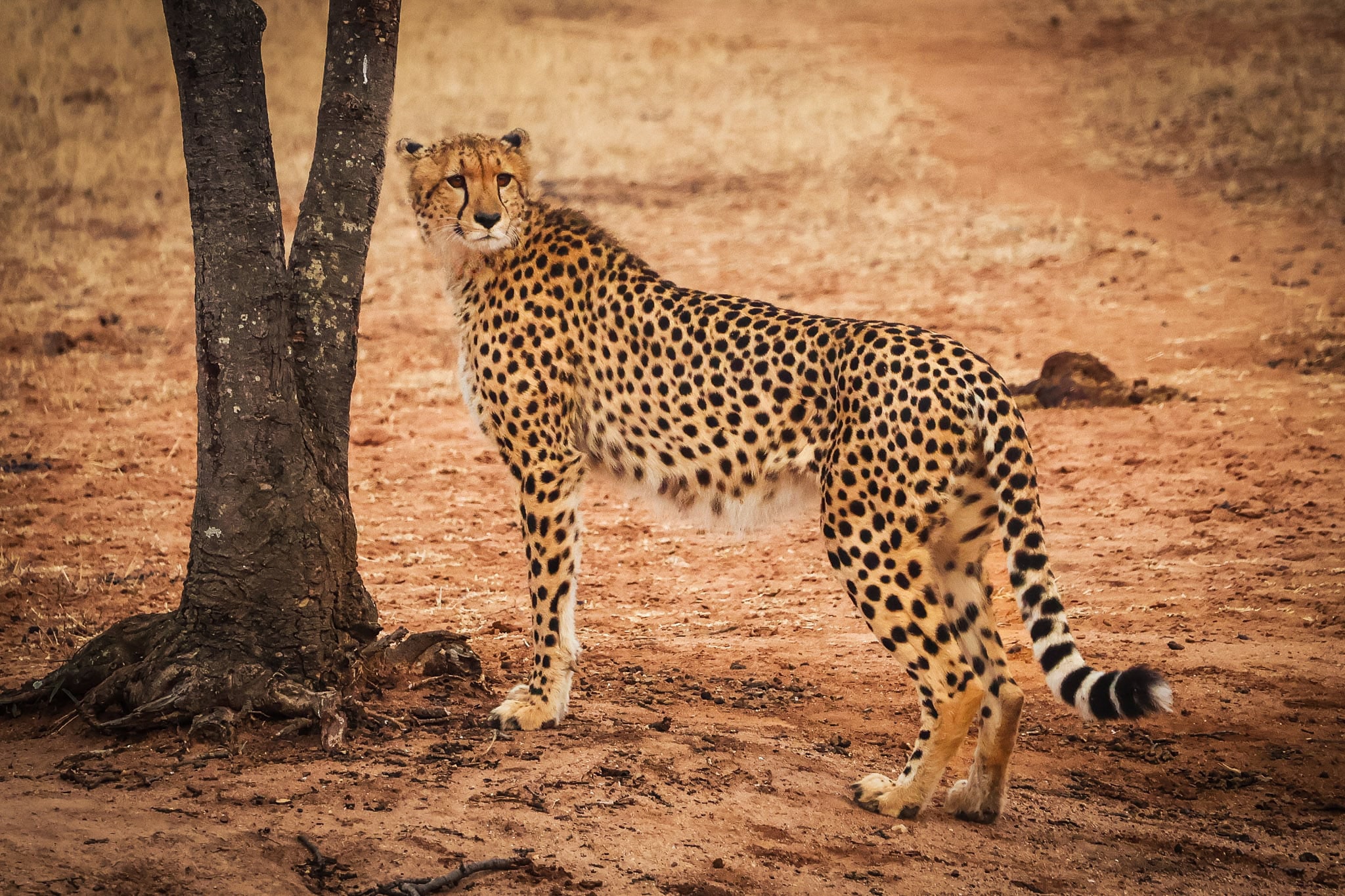Cheetah Photography: Guide with Tips & Tricks
One of the first ever wildlife photography trips I took was to Kruger National Park in South Africa, and I was lucky enough to get the chance to photograph cheetahs while I was there.
I was lucky enough to encounter multiple different cheetahs during my game drives, and even saw the same cheetah a few times.
To this day, they remain some of my favourite photos simply due to how majestic the cheetahs are. It’s almost impossible to take a bad shot of them.
That being said, if you’re reading this post, you want to take the best photo possible, so I’ve put together this guide with everything you need to know.
Where to see Cheetahs in the Wild
In order to get good photos of cheetahs you need one key thing: cheetahs.
Cheetahs are mostly found in sub-Saharan Africa, and they prefer living in open savannahs, making Tanzania, Kenya, Zambia, South Africa and Botswana the 5 best countries to find them.
Personally, I went to Moditlo Game Reserve and saw 3 different cheetahs during my time there.
But as long as you go to one of these 5 countries, you’ll most likely see cheetahs during your safari. They’re not the most elusive animal to find, that title goes to the leopard!
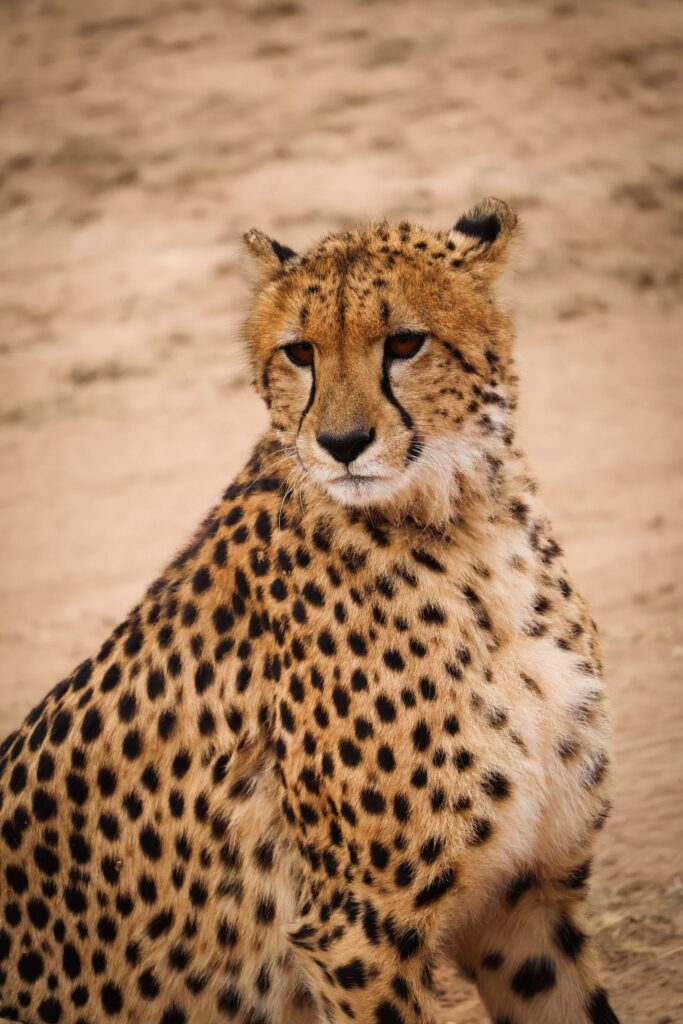
Tracking Cheetahs
To find cheetahs you have two options: go on a game drive, or self-drive a National Park.
Both have their benefits but if you really want to find cheetahs, a game drive is the better choice as you will have an expert driver and local tracker to do all of the hard work for you. I wouldn’t have had the same experience if it wasn’t for Uyai, my driver and Chris, my tracker.
Plus, it’s literally their job – they’re going to be so much better at tracking cheetahs than me or you. And if nothing else, they know the behaviour of the animals better so they can keep you safe at all times.

That being said, if you want to track a cheetah while on a self-drive safari, you want to be looking for tracks which are narrow, with 4 toes and nail prints. If there is a light layer of dust or sand on top of them, they are fresh; if there is not, they are old as the wind has blown it away.
This image does a good job of showing the different tracks you can look out for on your trip.
Other tell-tale signs are the prey species. Are the gazelle, impala, etc. all eating grass without a care in the world? If so, there’s probably not a cheetah (or any other predator) in the area.
Cheetah Behaviour
As always with wildlife photography, it’s a good idea to learn a bit about the animal you are photographing so you know what kind of shots you can get and when to expect them.
When it comes to cheetahs, if you have a house cat, you won’t need to do much research. They’re pretty much the exact same in terms of behaviours like rolling around, licking and grooming, and how they conduct themselves in general.
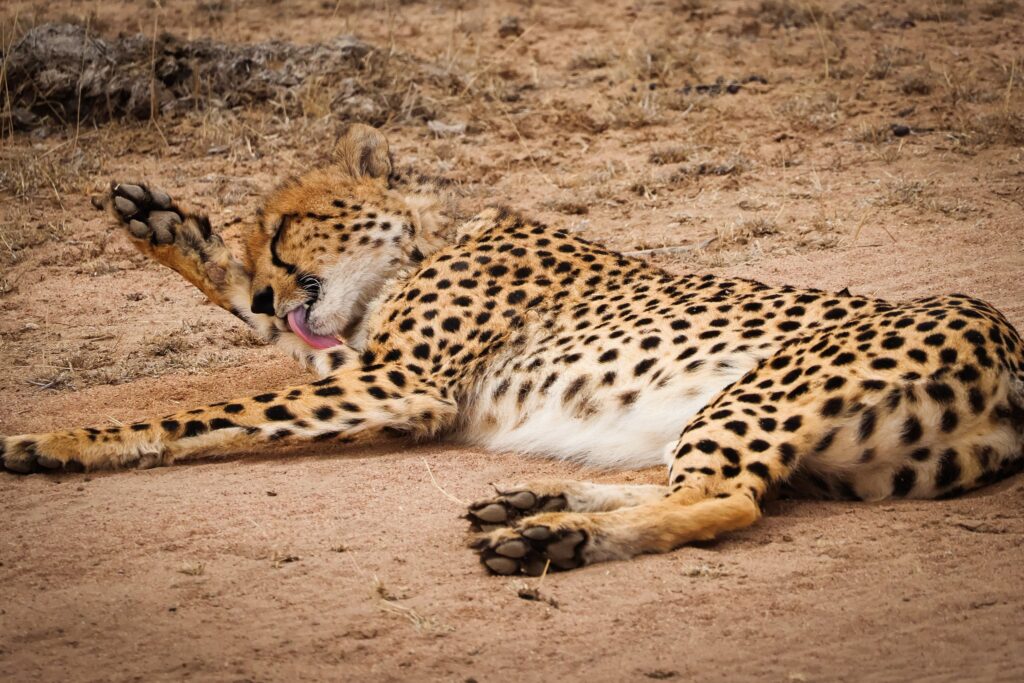
Even though they are predators, cheetahs are almost always on high alert. Despite being a predator, they are scared of other predators on the food chain like lions and even hyenas.
This means you’re guaranteed to get a shot of them looking back on themselves, which personally is the photo of a cheetah I pictured getting before my trip (and I got loads!)
Young cheetahs also love to play and play fight with each other when they are cubs. These make for some incredible shots but unfortunately, not ones I have captured myself (yet).
Seeing a cheetah hunt is an extraordinary experience, but it’s not the faint-hearted either. It’s the prized shot of a cheetah though, but you need to be lucky. Most of the time, the actual chase will only last 10 seconds, if even.
The majority of the time is spent stalking the prey as shown in the photo of the cheetah sniffing the tree earlier in my post. It’s important to keep your distance while this happens so you do not interrupt or disturb the hunt.
Cheetah Photography Tips
There are some general wildlife photography tips which apply to any animal such as using the rule of thirds and shooting on eye level (harder when on safari but still possible), but there are also some tips I picked up while photographing cheetahs, and here they are.
Take Advantage of Golden Hour
The soft, golden light around sunrise and sunset will enhance the cheetah’s coat and add warmth to your images. During the harsh midday sun, their spotted fur can look washed out. In the early morning or late afternoon, the light is flattering, and shadows add depth to the image. Orange light on yellow/orange fur never goes a miss!
Use a Fast Shutter Speed
Being the fastest animal in the world, cheetahs will quickly cause a lot of motion blur in your photos, especially if you’re lucky enough to capture a cheetah hunting. A shutter speed of 1/1000s or faster will freeze the action when they’re running. Even when stationary, you may need a faster shutter speed to capture any sudden movements.
Capture the Surrounding Environment
Showcasing a cheetah in its natural habitat adds context to your photos. Whether it’s the vast plains of the savannah, a dry bush, or grassy surroundings, include elements of their environment. This makes your images more dynamic and engaging. It’s also a good trick to use if your lens doesn’t have the reach you need.
One of the biggest mistakes when I first started was zooming in as far as I could to get a close-up. There’s no problem with this, but just don’t only get close-ups. Capture a variety!
Shoot in Burst Mode
When a cheetah starts running or hunting, everything happens incredibly fast. Set your camera to burst mode (continuous shooting) to increase your chances of getting that perfect action shot. Cheetahs can accelerate up to 75 mph, so the more frames per second your camera can capture, the better!
One of the things I quickly learnt as a wildlife photographer is it’s better to have 200 photos and only use one of them, than to have 10 photos and use none of them. Take more photos and delete more photos – it’s the best way of photographing animals.

Camera Equipment & Settings
- Camera: DSLR or Mirrorless with high frame rate.
- Lens: Telephoto lens (300-600mm).
- Shutter Speed: 1/1000th or faster.
- Aperture: f/4 to f/5.6 for shallow depth of field.
- ISO: 100-400 in daylight, higher in low light.
- Focus Mode: Continuous autofocus (AI-Servo/AF-C).
When it comes to photographing a cheetah, you’re going to want some pretty decent camera equipment and to make sure you have your settings set up right.
Don’t get me wrong, in today’s world, a phone can take a decent picture especially the Google Pixels and iPhone Pros, but nothing beats a proper camera.
When it comes to mirrorless vs DSLR, I’m always team mirrorless personally and normally it’s down to personal preference, but for wildlife, mirrorless is slightly better as usually they have faster burst modes, ideal for cheetahs, and a quieter shutter, ideal for any wildlife.
You’ll also want a telephoto lens, in other words, a camera length with a long focal length, so not your typical 18-55mm you get with most cameras.
All of the photos in this post were taken with a 200mm lens, but to be honest, I wish I had a bigger lens at the time, but this was towards the beginning of my photography journey. Ideally, you want a lens which can go to at least 500mm, or further.
The reality of safari is, tripods are unlikely to be useable as a lot of the time, you’ll be taking photos while the jeep is moving.

As for the technical side of photography, I would recommend a minimum shutter speed of 1/1000th of a second, or faster if they are sprinting. This allows you to capture each movement the cheetah makes without motion blur.
I would also use continuous autofocus so you do not waste time on manual focus as this could cause you to miss a shot. However, if you have plenty of time to capture photos of cheetahs and/or are a very experienced photographer, then you may prefer to use manual focus.
For aperture, f/4 to f/5.6 is about right depending on the lighting. This allows for a nice shot of the cheetah in focus with the background blurred. If you want the surroundings in focus too, go to around f/8.
Lastly, as always with wildlife photography, use your ISO to complement the shutter speed and aperture values you are using. If you are new to photography, this triangle is a good way to understand the basics.
Generally speaking, in environments where you’ll find cheetahs, in bright daylight, you can keep your ISO low, around ISO 100–400. If you see a cheetah in low-light situations, you might need to bump it up, but try not to go beyond ISO 1600 to avoid too much noise.
How to Edit a Photo of a Cheetah
Every photographer has their own unique editing style – two photographers could take the exact same photo, but how they edit it turns the photo into two completely different pieces of work.
While I don’t believe the saying that “good editing can turn an average photo into a good photo”, I do believe that a good photo without good editing can be a bad photo.
Nailing the shot is one thing, editing it is another. And both are just as important for the overall outcome.
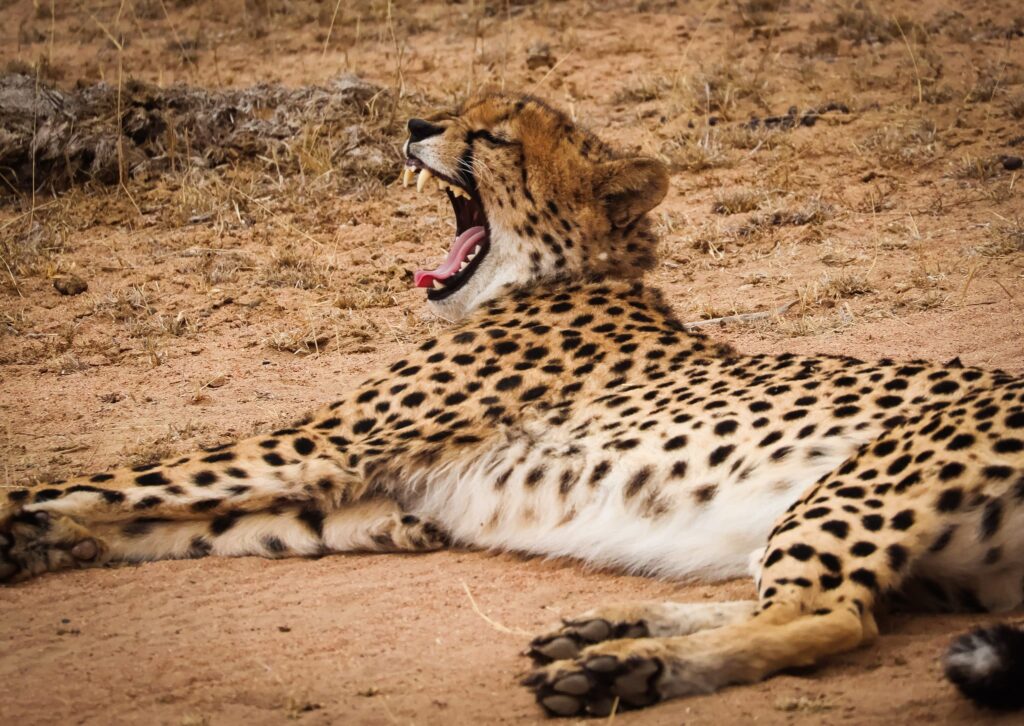
Naturally, every photo requires slightly different editing so as much as I would love to, I can’t sit here and say increase the exposure by 0.5, decrease the shadows by 0.3, etc.
Every photo is different and how you edit will depend on the composition, lighting and the story you want the shot to tell.
But if I had to give general tips from my own cheetah photos, I usually do the following:
- Increase contrast to make those spots stand out even more
- Decrease saturation of background depending on if you have dry orange sand landscapes like I did, to help the cheetah stand out more.
- Sharpen the image as with wildlife photography, you might not have a 100% sharp image every time
- Add a slight silhouette because in my opinion, it never goes a miss
- Crop to use the rule of thirds if you did not already manage to do this when taking the photo.
If you are wondering how to photograph lions, these are mostly the same editing settings I use for lions too.
Photographing Cheetahs Ethics
One of my biggest pet peeves in life is people not being ethical while calling themself a wildlife photographer. How can you simultaneously care about animals to photograph them but not care enough to respect them?
If you’re reading this, I’m sure you have the intention of being ethical, but it never hurts to go over the basics. If you’re on a safari, your driver will remind you of these as well.
- Do not bait or lure: Half of the fun of wildlife photography is finding the animal. Don’t ruin the fun and or disrupt a cheetah’s hunting pattern by baiting them with food.
- Be quiet: Do not make noises to catch the cheetah’s attention – even if it means missing out on a shot of them looking down your lens
- Avoid flash: To be honest, you’re most likely to see cheetahs during the day but if you do see one at night, increase your ISO rather than using flash.
- Keep your distance: Obviously if you’re on a safari, you can’t control this at the time, so I would say to read reviews in advance and make sure you are choosing an ethical company. That being said, you can get really close to cheetahs while still being ethical and most of the time, they’ll completely ignore you. One cheetah walked less than a metre past our jeep as if we weren’t there!
- Respect conservation efforts: Some cheetahs will be wearing collars depending on where you are. This is because the national park or reserve are tracking their behaviours to make sure everything is normal. It’s not ideal for photos but it’s easy enough to photoshop them out, especially with the world of AI and generative fill.
- Don’t litter: It should go without saying but unfortunately this photo I captured says otherwise.

Conclusion
And there you have it, a complete guide to cheetah photography.
To summarise, use a fast shutter speed on a mirrorless camera to capture every move the cheetah makes without motion blur.
You’ll get the best photos using a telephoto lens at sunrise or sunset as the colours shine perfectly on their fur.
Enjoy your time photographing cheetahs, I’m sure you’ll have a lot of fun – I know I did!
